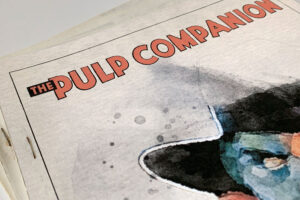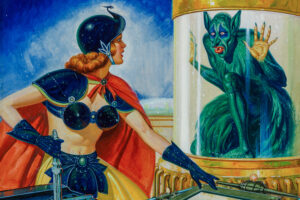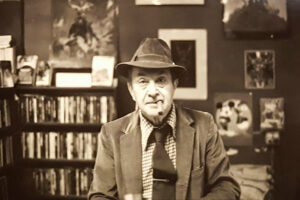In 1939, a barbarian, a thief, Fritz Leiber Jr. began a journey of a lifetime.

Out of the smoldering creative fires of sword-and-sorcery, in 1939 a career was born.
“Two Sought Adventure” saw print that August in the pulp Unknown — the first professional sale for Fritz Leiber Jr., who would go on to become one of the most-awarded writers in 20th-century imaginative literature.
The characters introduced, the barbarian Fafhrd and the wily Gray Mouser — the two best thieves in Lankhmar, and the two best swordsmen — would have many more adventures with the author till the end of his life.
Leiber was almost 30 when he penned the tale. Born Dec. 24, 1910, son of the Shakespearian actor Fritz Leiber, he grew up in and around theatre. As a single example of this heritage, he knew by heart the entire play “MacBeth” from listening to countless rehearsals in his youth; I wouldn’t think it coincidence that he selected the title for his first book from Act III, the line “While night’s black agents to their prey do rouse.”
When he was 16, Leiber encountered another seminal influence when he read H.P. Lovecraft’s “The Colour Out of Space” in the September 1927 issue of Amazing Stories. At that point he found the fiction in Weird Tales too creepy for his tastes, saying in the memoir “Lovecraft in My Life” that this bleak tale of cosmic horror “put me off Amazing Stories, which hitherto had pleased me with its tales in which science could solve almost any mystery.” It frightened the teenager and “depressed me for weeks.”
Fanzine flashback
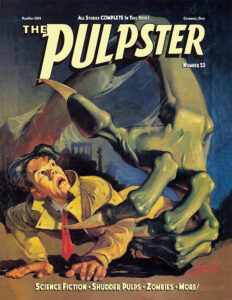 This article originally appeared in The Pulpster (#23) for PulpFest 2014. Reprinted with permission.
This article originally appeared in The Pulpster (#23) for PulpFest 2014. Reprinted with permission.
Science fiction and horror are now two of the three genres most associated with his byline.
In 1932 at the University of Chicago, Leiber caught up with Lovecraft’s published works via a collection of tearsheets borrowed from an acquaintance, and after that followed Lovecraft’s output as it appeared, memorably reading aloud to his new wife Jonquil Stephens the serial installments of “At the Mountains of Madness,” a novel of Antarctic horrors, as they appeared in Astounding Stories during the early months of 1936 during “a protracted spell of zero weather.”
Those college years brought him into contact with new friends, notably Harry Otto Fischer. They kept in touch by letter afterwards and began to spin out casual shared-world cycles of ideas and story fragments. “First,” Leiber recalled in the essay “Fafhrd and Me,” “there was the universe of the Elder Gods, shading into the realm of Loki and the trolls, which grew equally from the Elder Edda and Peer Gynt.”
Then, in a letter from September 1934, Fischer’s imagination kicked in with something new, a background and situation almost fully formed in an instant, inhabited by: “the one known as the Gray Mouser. He walks with swagger ’mongst the bravos, though he’s but the stature of a child. His costume is all of gray, from gauntlets to boots and spurs of steel.”
The diminutive Fischer describes his avatar at some length, down to his throwing knife Cat’s Claw and his sword, the Scalpel. Another paragraph introduces “the walled city of the Tuatha De Danaan called Lankhmar … built on the edge of the Great Salt Marsh” and provides his friend with an adventurous avatar of his own in the figure of Fafhrd, a “full seven feet in height” (Leiber fell only a few inches short of that mark). Fafhrd’s sword was not yet named.
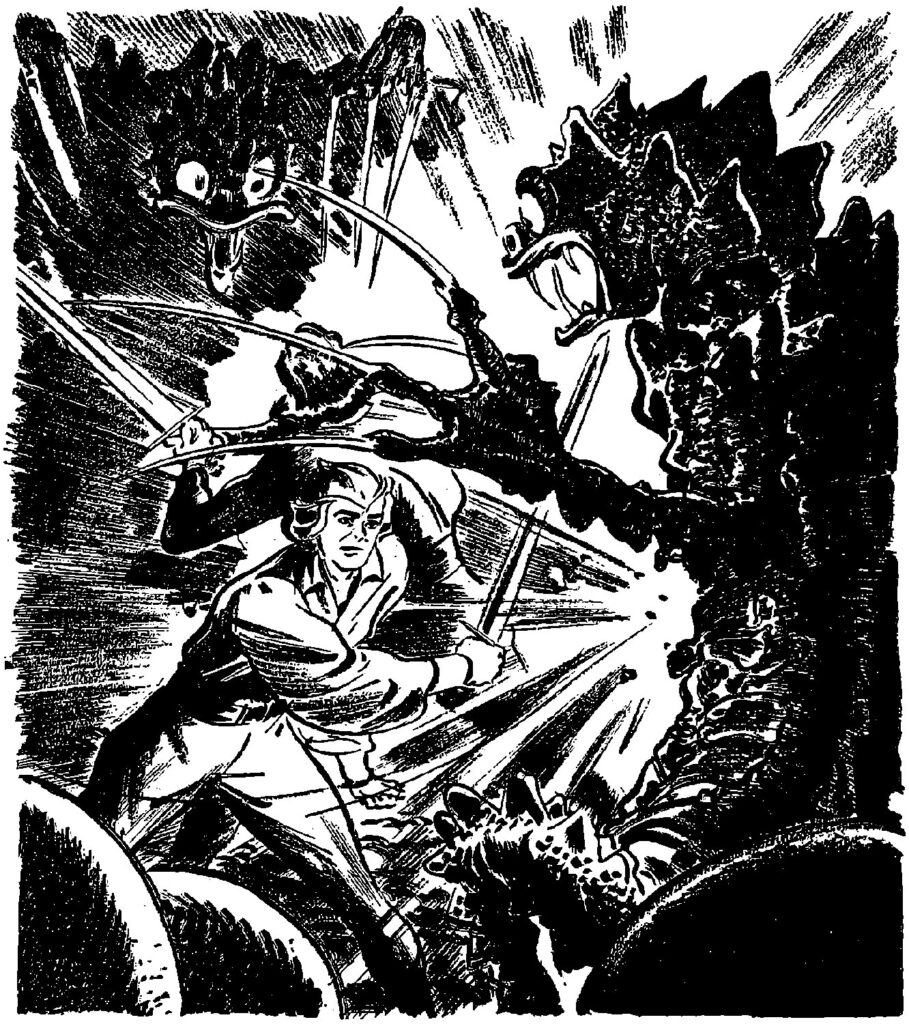
Fischer and Leiber batted concepts and fragments back and forth — eventually constructing a board game called “Lankhmar” to occupy idle hours during the Depression (avatars of this game, such as Dungeons and Dragons, lay decades in the future).
It was Leiber who put serious effort into making viable fiction out of the characters. He began the tale now known as “Adept’s Gambit” in autumn 1935 and finished early in 1936. Rejections came back from “several book publishers,” and it also was bounced by Farnsworth Wright, the famously erratic editor of Weird Tales, “as being too full of stylistic novelties.”
Naturally Leiber would have thought of Weird Tales as a likely market, since it was in those pulp pages that sword-and-sorcery as we know it sprang to life, after being pounded out on an Underwood in a small room in Cross Plains, Texas, by prolific fictioneer Robert E. Howard.
Hints of what was to come invested “Red Shadows” (Weird Tales, August 1928), the first exploit of the swashbuckling Puritan adventurer Solomon Kane, but the full-blown genre erupted volcanically in “The Shadow Kingdom” (Weird Tales, August 1929), in which Howard introduced the brooding figure of King Kull, reigning over the fading land of Valusia in a Pre-Cataclysmic Age, with Atlantis newly risen above the waves. Kull’s blood-splashed clash with the serpent men who lurk behind his throne laid down an iron template, as black magic is met with swordplay, a hero faces horror and triumphs. Kull returned in “The Mirrors of Tuzun Thune” (September 1929), ensorcelled in a magic chamber by questions: What is real? Which Kull of all Kulls from youth to king is his true self? Such philosophical concerns also would haunt the saga of Fafhrd and the Gray Mouser.
Any doubt that the young Texan had created a new sort of fiction — combining fantasy, adventure and horror, folk myth and classical mythology, yet something inevitably its own — vanished with the spectacular advent of Conan the Cimmerian in “The Phoenix on the Sword” (December 1932), a definitive clash of swords versus sorcery. It was akin to the game-changing moment when Edgar Rice Burroughs created Tarzan of the Apes.
Suddenly, Weird Tales had the adventures of Conan to carry it through the Great Depression, as Howard’s titanic imagination spun out one exploit of the barbarian after another: “The People of the Black Circle” and “Beyond the Black River” high points among the many, with the brutal, headlong “Red Nails” appearing posthumously after Howard killed himself with a gunshot to the head at age 30 on June 11, 1936.
Intriguingly, even as Harry Fischer conjured up the first invocations of Fafhrd and the Mouser in his September 1934 letter, another writer had joined in on the sword-and-sorcery action in Weird Tales.
For the October 1934 issue — on the newsstands at least a month before the cover date — C.L. Moore (who had created a sensation with her first published story, “Shambleau,” in the November 1933 issue) introduced the medieval swordswoman Jirel of Joiry in “The Black God’s Kiss.”
By any reasonable expectation, the pulp was open to more such yarns, but when Leiber completed “Adept’s Gambit” early in 1936 it met the enigmatic blank wall of Wright’s editorial taste.
Nonetheless, that year marked the turning point for Leiber, the moment he set out to make a literary career for himself and never turned back. He tried other jobs, such as acting; from performing with his father’s Shakespeare company, he even landed a bit part in Greta Garbo’s 1936 film Camille, though in his scene with Robert Taylor he had to stand in a trench so he wouldn’t grotesquely overshadow the much shorter leading man. Leiber’s longest-lived “day job” became working as an associate editor on Science Digest out of Chicago from 1945-56, before he finally went full freelance in the late 1950s. But these diversions simply helped pay the bills: from 1936 onward, writing was Leiber’s career.
If a finished story wasn’t enough to commit him to the craft, in 1936 his wife Jonquil wrote to none other than Lovecraft himself via Weird Tales, instigating a typical fast-and-furious exchange of letters with the master of supernatural horror. Leiber jumped in, too, and sent Lovecraft at least one of the “three or four recastings and rewritings” he would do of “Adept’s Gambit” — Lovecraft suggested that he didn’t need to include allusions to the Cthulhu pantheon that made their way into the draft, in tribute to the senior writer.
Then, on March 15, 1937, came the unexpected death of Lovecraft at age 46.
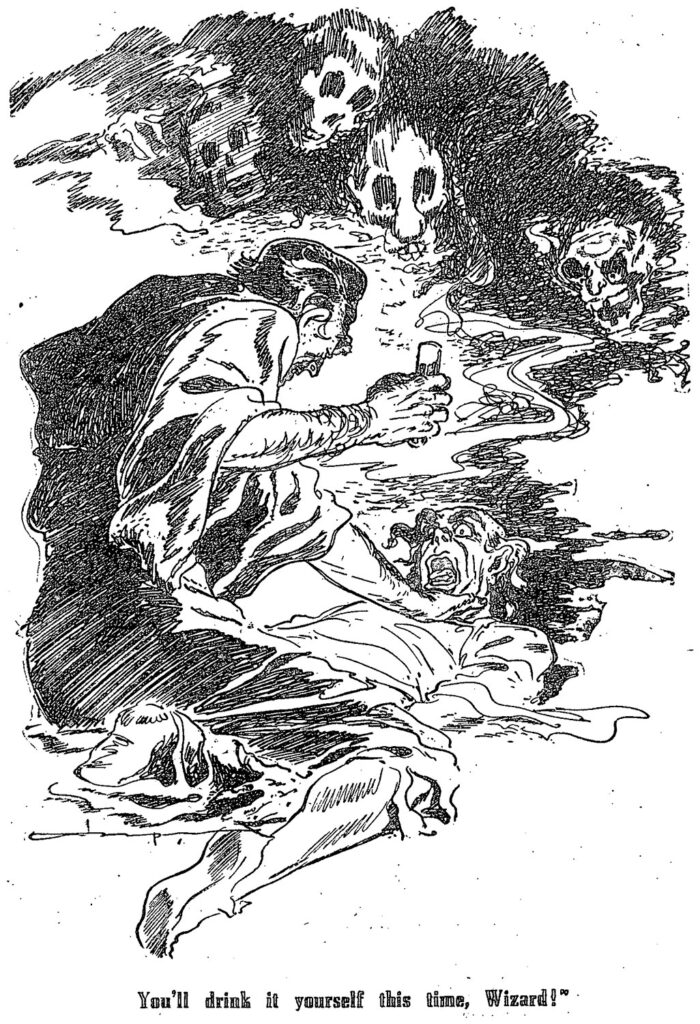
Certainly Leiber would become the major critic of the supernaturalist with such articles as “A Literary Copernicus” (1949) and “Through Hyperspace with Brown Jenkin” (1966), laying out overtly or implicitly almost every concept that Lovecraft critics have toyed with since then.
How fascinating would have been a Weird Tales circa 1938 with Lovecraft — and Robert E. Howard, what the hell — still alive and Leiber welcomed into the ranks with Moore, Clark Ashton Smith, and the other major talents.
In some alternate reality, perhaps. …
In this world, 1938 saw John W. Campbell take over the reins of the science-fiction pulp Astounding. By 1939 the Golden Age of Science Fiction was begun, with the brassy new editor buying first stories from A.E. van Vogt, Robert A. Heinlein, Theodore Sturgeon — and Fritz Leiber.
Leiber made it into that group of up-and-coming superstars through the back door. While it would last only four years, a victim of wartime paper shortages, in 1939 Campbell launched a companion pulp titled Unknown (and later, Unknown Worlds) devoted not to tales of science but to fantasy. Leiber’s lone sale that year proved he’d been working at his craft, and that Fafhrd and the Mouser still gripped his imagination.
“Two Sought Adventure” features the pair of rogues on a quest to find a cache of jewels hidden in a “great treasure house with a high tower” in a remote valley, ambushed by rival thieves, and ultimately in a fight for survival against the house itself, come to sorcerous life. And what Leiber fan could not appreciate the animated building, long foreshadowing of the idea of marching cities from Leiber’s World Fantasy Award-winning 1977 novel Our Lady of Darkness?
Campbell would accept further adventures of the swordsmen. “The Bleak Shore” saw print in Unknown (November 1940), followed by “The Howling Tower” (June 1941), “The Sunken Land” (February 1942), and “Thieves House” (February 1943). As Leiber wrote in “Fafhrd and Me”:
Oddly, no Fafhrd-Mouser story was ever published in Weird Tales, though more than one was submitted there, all but “Adept’s Gambit” in the period after Farnsworth Wright. My “oddly” was confirmed by John W. Campbell Jr., who more than once remarked in accepting a story, “This is more of a Weird Tales piece than Unknown usually prints. However — ”
Leiber did crack Weird Tales a few times with his horror fiction, first in May 1940, the exact issue when Dorothy McIlwraith took the editorial chair from Wright. And he landed more and more fiction each year — his pioneering tale of modern horror “Smoke Ghost” in Unknown for October 1941, the complete novel “Conjure Wife” in Unknown Worlds for April 1943.
By 1947 Leiber had enough material — and enough of a reputation — for August Derleth at Arkham House to publish his first book, Night’s Black Agents, collecting “Smoke Ghost” and others, capped off with the Fafhrd and Gray Mouser adventures “The Sunken Land” and — its first time in print — “Adept’s Gambit.” The foreword quotes in full the September 1934 Harry Fischer paragraphs which introduced the heroes to Leiber, and from there to the world.
Sword-and-sorcery achieved another landmark in 1950, when Gnome Press brought out Conan the Conqueror, the only novel-length work by Robert E. Howard featuring his most famous creation. More collections of Conan tales from the archives of Weird Tales followed.
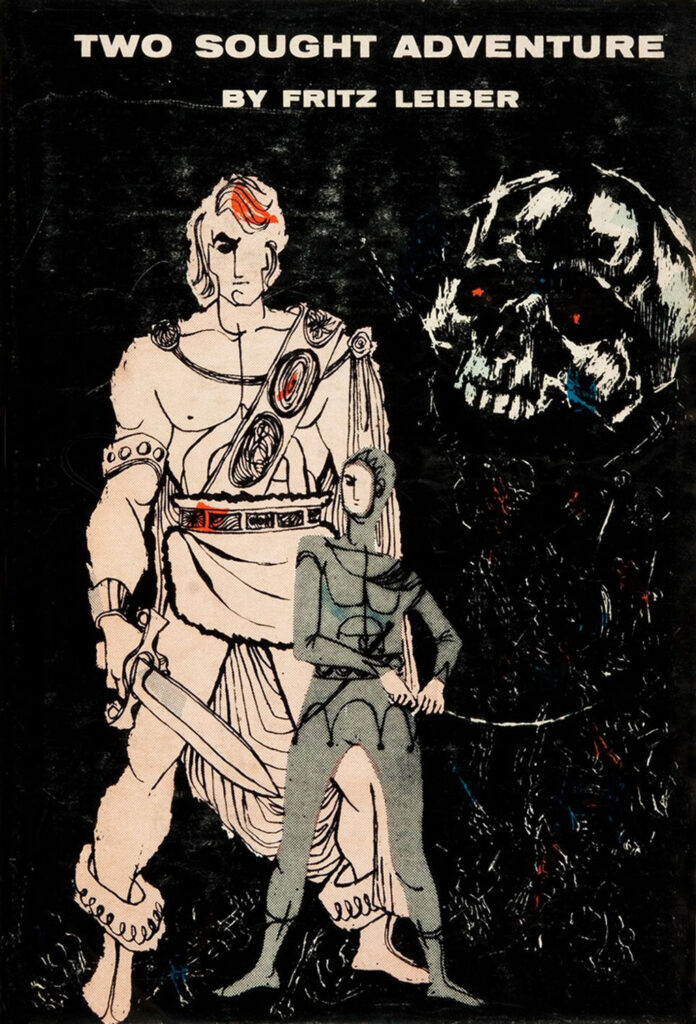 Although he was concentrating more on science fiction and on novels himself, Leiber did squeak in another Fafhrd and Mouser yarn in 1951, “Dark Vengeance” (a.k.a. “Claws from the Night”) for Suspense, and “The Seven Black Priests” in Other Worlds Science Stories for May 1953.
Although he was concentrating more on science fiction and on novels himself, Leiber did squeak in another Fafhrd and Mouser yarn in 1951, “Dark Vengeance” (a.k.a. “Claws from the Night”) for Suspense, and “The Seven Black Priests” in Other Worlds Science Stories for May 1953.
Adding to their growing stocklist of sword-and-sorcery titles, in 1957 Gnome Press issued Two Sought Adventure, gathering the five stories published by Campbell and the two most recent.
For a moment in time it seemed as if that collection might be the solitary tomb for the Fafhrd and Mouser saga, as Leiber devoted himself to stories of the Change War and other literary interests. From 1953 until 1959 no new adventures appeared in print. The creative fires of sword-and-sorcery were banked.
But during that period Leiber’s interest in the characters and the genre revived, in part because of his friendship with other writers who began working that territory, such as L. Sprague de Camp (The Tritonian Ring, 1953) and Poul Anderson (The Broken Sword, 1954). New writers arrived on the scene with characters of their own — John Jakes with Brak the Barbarian, Michael Moorcock with Elric and other incarnations of his Eternal Champion.
They knew they had a distinct genre on their hands, but they didn’t know what exactly to call it.
Leiber gave it a name.
In the first issue of his fanzine Ancalagon for March 1961, George R. Heap — secretary to the Philadelphia Science Fiction Society and soon to found the better-known fanzine Amra — speculated on Howard-inspired fiction, which caused Leiber to reply in the second issue for April 1961 that Howardian fantasy-adventure was:
… a field which I feel more certain that ever should be called the sword-and-sorcery story. This accurately describes the points of culture-level and supernatural element and also immediately distinguishes it from the cloak-and-sword (historical adventure) story — and (quite incidentally) from the cloak-and-dagger (international espionage) story, too! The word sorcery implies something more and other than historical human witchcraft, so even the element of an alien-yet-human world background is hinted at. … At any rate, I’ll use sword-and-sorcery as a good popular catchphrase for the field. It won’t interfere with the use of a more formal designation… when one comes along or is finally settled on.
Leiber had returned to the genre with a vengeance with “Lean Times in Lankhmar” in the November 1959 issue of Fantastic. Here was a writer with 20 years experience now under his belt, fresh off winning a 1958 Hugo for the novel The Big Time. The early stories for Campbell and Unknown were good, but “Lean Times” was a masterpiece. The plot? Fafhrd and the Mouser have split up. The Mouser has grown fat and lazy, now acting as an enforcer. Fafhrd has gotten religion. Hilarity of the side-splitting variety ensues.
Fantastic became the new homebase for the two swashbucklers, with “When the Sea-King’s Away” (May 1960), “Scylla’s Daughter” (May 1961), “The Unholy Grail” (October 1962), “The Cloud of Hate” (May 1963), and “Bazaar of the Bizarre” (August 1963). Next Leiber took a long fragment that Harry Fischer had begun and completed it as a two-parter, “The Lords of Quarmall” (January-February 1964). Then came “Stardock” (September 1965) and “The Two Best Thieves in Lankhmar” (August 1968).
In those years the market for paperback fantasy exploded, first with the Burroughs Boom, then as Tolkien’s Lord of the Rings became a cult hit on college campuses. In 1966 Lancer Books released Conan the Adventurer — an instant best-seller featuring iconic Frank Frazetta cover art.
As the Conan series went into wraps, and Moorcock and others hit the newsstands with new sword-and-sorcery series, Leiber decided he should do a “complete” Fafhrd-Mouser set — even if it meant working from the back to the front, then from the earliest part of the saga jumping to the last.
First he expanded “Scylla’s Daughter” into the full-length, and excellent, novel The Swords of Lankhmar, published in paperback by Ace Books in 1968. While a great introduction to the characters and setting, this would ultimately be volume five of the standard six volume set.
Swords Against Wizardry followed almost immediately in 1968, with the vignette “In the Witch’s Tent” written just for the book, backed up by “Stardock,” “Two Best Thieves” and “Quarmall” — volume four of the six-book set. Volume three also saw print that year as Swords in the Mist, with six tales, among them “Lean Times” and “Adept’s Gambit.”
Skip ahead to 1970, as Leiber finished an “origin story” for Fafhrd, “The Snow Women,” appearing that April in Fantastic (he’d already covered the Mouser’s beginnings in “The Unholy Grail”). And the story that united the pair forever also appeared in April in The Magazine of Fantasy and Science Fiction — “Ill Met in Lankhmar,” which seemed to howl out in grief over the passing of his wife Jonquil in September 1969, as the two friends lose their lady loves to death. A powerful piece of fiction, “Ill Met” won the Best Novella category in both the Hugo Award voting and the Nebula Awards from the Science Fiction Writers of America.
Swords Against Death — volume two of the set — came out from Ace in 1970, collecting mostly from the early sales to Unknown. At this point “Two Sought Adventure” was retitled “The Jewels in the Forest,” and a bit of pulp history was lost. Volume one followed under the title Swords and Deviltry, with the origin tales and “Ill Met.” For the moment the saga paused.
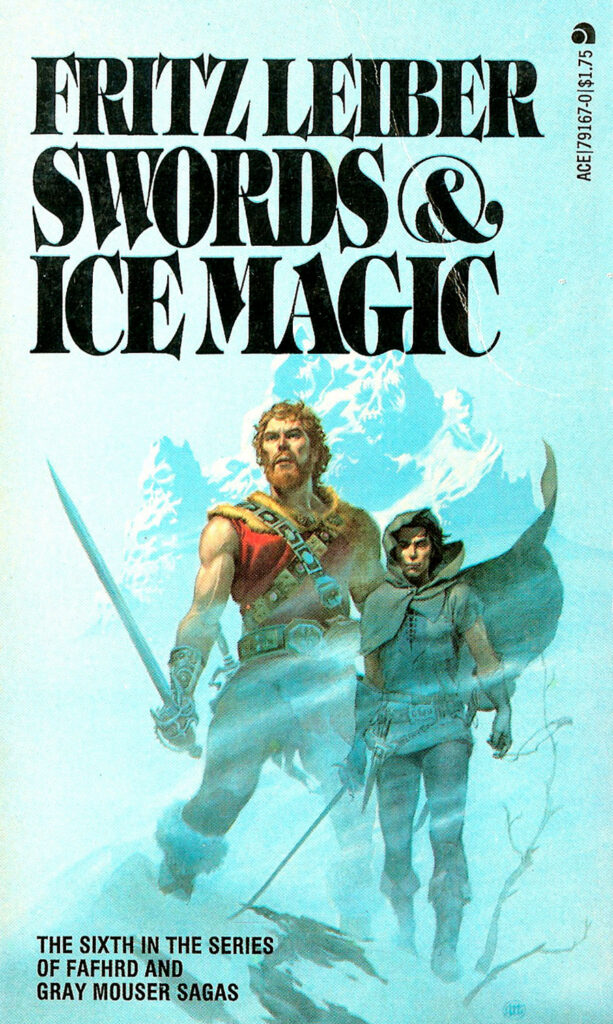 By 1977, Leiber had written enough material for a concluding volume six, published in paperback as Swords and Ice Magic by Ace in 1977 — and that year the set was released in hardcover in a uniform edition by Gregg Press. Now the saga could be said to be complete; in 1978 Donald M. Grant published as an oversized hardcover Bazaar of the Bizarre — collecting the title yarn, “The Cloud of Hate,” and “Lean Times in Lankhmar” as Leiber’s choices for his favorite episodes in the series.
By 1977, Leiber had written enough material for a concluding volume six, published in paperback as Swords and Ice Magic by Ace in 1977 — and that year the set was released in hardcover in a uniform edition by Gregg Press. Now the saga could be said to be complete; in 1978 Donald M. Grant published as an oversized hardcover Bazaar of the Bizarre — collecting the title yarn, “The Cloud of Hate,” and “Lean Times in Lankhmar” as Leiber’s choices for his favorite episodes in the series.
Sometime circa 1983 or so, I had the immense pleasure of meeting Harry Otto Fischer when he was visiting Fritz Leiber in San Francisco.
I’d known Fritz since 1974, and at various times saw him quite a lot — I got his okay to take pieces he’d written on Robert E. Howard and edit them together for my critical anthology The Dark Barbarian from Greenwood Press (1984). He knew my disagreements with L. Sprague de Camp over the idea that sword-and-sorcery was just something that was “fun to read, and fun to write” and nothing more. So he added a new bridge between sections, pretty much just for me — and because it needed to be stated emphatically:
Now some say, “Enjoy the Conan yarns as hot-blooded, heroic escape-fiction. Why get serious about them?” Nonsense! Anything I like as well as I do some of the Conan stories, I do the courtesy of taking seriously when I write about them.
I arrived early and found none other than the Gray Mouser somehow incarnate — a small man, bright dark eyes behind thick glasses, eloquent, blunt, funny, and incredibly likable. More people rolled in: Charles Brown (publisher of Locus), Poul Anderson, others.
While Fritz at that time was on the wagon, Harry imbibed as if he were in the Silver Eel tavern in Lankhmar.
At one point Harry looked drunkenly at Fritz and said: “Fritz, you let me down.”
Fritz did an astonished double-take. “When, Harry, when have I ever let you down?”
Harry began a tale of how he had been trapped in his bathtub back in Kentucky, trying to get out, slipping back in. “I yelled, ‘Fritz! Help me, Fritz!’ You didn’t come.”
More astonished, Fritz protested: “But, Harry, I was here in San Francisco!”
Harry looked at him with disappointment. “Exactly, Fritz. You let me down.”
I felt as if I had stepped into “Bazaar of the Bizarre” — the logic was the same, the characters were, well, real.
Fischer died in 1986. I stopped in on Fritz sometime after and learned that instead of writing letters, in the last years he and Harry had sent tape cassettes back and forth, often recording over the tape just received and popping that back in the mail.
He told me that Harry’s son had found a last tape in the recorder that had not yet been sent, and shipped it to him. I got to listen to it that one time, as the original of the Mouser implored Fritz: “Remember me!”
Genuinely haunting. A lost voice from a friendship of a half century.
Three new pieces featuring Fafhrd and the Mouser had appeared after book six of the series saw print, though who knows if Leiber would ever have done enough for another full book?
But now he sat down and created a final tribute to his friend in the form of the short novel “The Mouser Goes Below,” which I very much like — a minor masterpiece, at least. Perhaps my regard is tinged by the glow of meeting Fischer in person, but then that is life.
I liked the Fafhrd-Mouser tales before meeting either of the originals, but I appreciate them all the more for knowing the actual people behind the fictive curtain.
This last tale with his heroes rounded out a seventh volume, The Knight and Knave of Swords — not done to match the Ace paperback series but as an elegant hardcover from William Morrow and Co., published in 1988.
Leiber himself would pass into the Shadowland and encounter Death (often on scene in the saga) on Sept. 5, 1992. Fifty-eight years spent living with Fafhrd and the Gray Mouser, and those deep creative fires of sword-and-sorcery glowed a deep red until the end.
About the author
Don Herron has led the Dashiell Hammett Tour in San Francisco since 1977. He featured Fritz Leiber in his guide book The Literary World of San Francisco, and often mentions him and other pulp writers on his blog at donherron.com.


